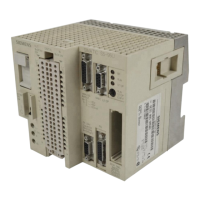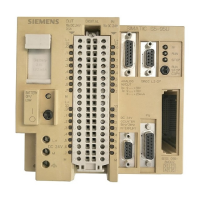S5-115F Manual Rules Governing the Use of the S5-115F
In the case of an error, the SINEC L1 response time increases to:
SINEC L1 response time=SINEC L1 response time in error-free operation+(T
SINEC safety
- T
SINEC poll
)
The following applies if you use OB 13 to evaluate the Receive mailbox:
SINEC L1 response time T
synchr. S
+ T
SINEC poll
+ T
synchr. SINEC R
+ T
OB13
+ T
synchr. OB 13
This response time only includes the time between sending a message and its arrival at the receiver.
If an input signal is transferred from an S5-115F via the SINEC L1 LAN to another S5-115F, the time
required for detecting the signal change at the input and for responding at the output must be
taken into account.
10.4 Defining the PLC Cycle Time
The PLC cycle time is a safety variable. It is instrumental in defining the response time of the PLC,
which, in turn, is an essential component of the safety time.
The following applies:
• PLC response time 2
·maximum PLC cycle time
• Safety time = PLC response time
+ Response time of electromechanical components (relays, sensors)
+ Response time of mechanical parts (press rams, etc.)
For this reason, you must be able to define the worst-case cycle time.
The worst case cycle time consists of
• The program execution time
• The operating system execution time.
You can determine your program execution time by summating the execution times of the STEP 5
statements constituting the program.
The maximum operating system execution time can be estimated with the help of the following
guidance values:
• 60 to 80 msec. Basic execution time depending on configuration with user timers in con-
junction with the IA (Interrupt Inhibit) operation.
• 70 to 90 msec. Basic execution time without IA operation
• 0 to 30 msec. (30 msec. for short discrepancy time) for the configured short discrepancy
time
for cyclic updating of digital input modules without interrupt capability
• 5 to 10 msec. For supplementary PLC self-test in the case of normal test slice size
or
15 to140 msec. In the case of larger-than-normal test slices. This test consists of several
components that depend on the I/Os. The test runs serially and executes
normal and larger-than-normal test slices.
Larger-than-normal slices are:
25 to 70 msec. for the DI module test (type 3)
15 to 140 msec. for the DQ module test depending on the type of control
(direct or indirect) and the inertia of the 24 V/220 V
module
50 to 120 msec. for the AI module test (type 14, 15)
The PLC cycle time can be extended by
• Process interrupt servicing with OB 2
• Time interrupt servicing with OB 13
• Synchronization of the SINEC L1 LAN.
EWA 4NEB 811 6148-02
10-7

